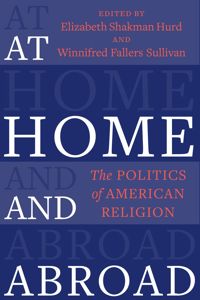
Border Work: Review of “At Home and Abroad: The Politics of American Religion”
Brent Nongbri
Photo by Thaï Ch. Hamelin on Unsplash.
This article is part of our “At Home and Abroad” series.
If you’d like to check out other articles in this series, click here.
It’s no secret that tensions exist in the ways that the government of the United States treats “religion” in different contexts. In the domestic sphere, private corporations can, as of 2014, essentially opt out of obeying the laws they deem incompatible with their “sincerely held religious beliefs.” Yet in terms of foreign policy, the same U.S. government spent twenty years and an estimated two trillion dollars in a failed attempt to topple the Taliban, which was seeking to enact its own “sincerely held religious beliefs” in Afghanistan. For the casual observer of such tensions, descriptors like “inconsistent,” “double standard,” and even “hypocrisy” come to mind. While the thought-provoking essays collected and edited by Elizabeth Shakman Hurd and Winnifred Fallers Sullivan in At Home and Abroad do not ask us to deny this initial impression, they do ask us to dig a bit deeper. Each chapter challenges us to question the degree to which oppositions like “home and abroad” and “religion and nonreligion” can be so neatly divided in the first place.

The essays cover a wide geographic and chronological span, with studies focusing on data ranging from the Philippines to Puerto Rico and from the colonial era to the present. The temporal scope of the chapters also varies widely, from the span of several decades (Evan Haefeli’s “American Religion from Colonies through the Civil War”) to just a few days (M. Cooper Harriss’s “On the Abroad of a Different Home: Muhammad Ali in Micro-Scope”). Yet, the essays form a cohesive whole atypical of collections like this. The authors of the chapters make a conscious effort to engage with each other. As a result, one comes away from the volume with a sense that something like a coherent thesis is being put forward from several different angles. That thesis might be summarized as: ideas of “home,” “abroad,” “borders,” and “religion” are always ambiguous and unstable, and as such, many social actors must invest a lot of effort in making it appear that these concepts are clear, stable, natural, and necessary. A subsidiary thesis might hold that scholars should direct their attention more at these processes of boundary creation and maintenance, and less at the supposedly stable categories, like borders or religions, that result from these efforts.
Ideas of “home,” “abroad,” “borders,” and “religion” are always ambiguous and unstable, and as such, many social actors must invest a lot of effort in making it appear that these concepts are clear, stable, natural, and necessary.
Given the volume’s emphasis on testing the limits of the concepts “home” and “abroad,” it is quite fitting that several of the essays deal with colonialism, a topic which immediately complicates the home/abroad distinction. Haefeli’s chapter, mentioned above, traces ecclesiastical contests during and after the transformation of the American colonies from England’s “abroad” into a new “home” in the form of the United States. The focus narrows further in David Maldonado Rivera’s contribution (“A Perfect Irrevocable Gift: Recognizing the Proprietary Church in Puerto Rico 1898-1908”), which offers an in-depth look at legal disputes that established “the juridical personality of the Catholic Church in Puerto Rico” at the turn of the twentieth century. The blurred boundary between home and abroad is nicely illustrated in Nancy Buenger’s study of equity law in the United States and the Philippines during roughly the same period (“Home Rule: Equitable Justice in Progressive Chicago and the Philippines”). Buenger cleverly uses the figure of William Howard Taft in his capacity as a colonial governor in the Philippines and in his later role as chief justice of the U.S. Supreme Court to exemplify ways in which the colonial experience (in this case, Taft’s exposure to Spanish law in the Philippines) informed legal theory and practice domestically in the U.S.
A second set of essays deals less with colonialism itself and more with its lingering effects. Using the examples of repatriation of human bones and disputes over land usage, Greg Johnson (“Domestic Bones, Foreign Land, and the Kingdom Come: Jurisdictions of Religion in Contemporary Hawaii”) leads us through the crisscrossing avenues for legal redress open to native Hawaiians. While state and federal courts have been effective in cases concerning human bones, they have been less helpful in land disputes, with the result that many native Hawaiians have begun to appeal to “inherent sovereignty” (or “auto-jurisdiction,” in Johnson’s terms) as a means of contesting the asserted sovereignty of the United States over Hawaii. Across the Pacific, Jolyon Baraka Thomas (“Double Standards in a Tripartite World”) frames recent efforts by the Japanese government to embed aspects of Shinto practice into civic life against the backdrop of American-led efforts in the 1940s and 1950s to reform “religious” education in Japan. Thomas concludes that modern Japan, as an “enemy-turned-ally” of the U.S., represents an ambiguous space that is neither “home” nor “abroad,” which may help to explain why recent protests about infringement of religious freedom in Japan have not been as alarming to Americans as similar protests in other countries. Sunila S. Kale and Christian Lee Novetzke (“The Cultural Politics of Yoga in India and the United States”) use American anxieties about the cultural appropriation of yoga to launch an intriguing investigation into the surprisingly malleable concept of yoga within Indian history, noting along the way that some key aspects of yoga as it has come to be known outside India coalesced in the crucible of the British colonial encounter.
In a pair of more explicitly theoretical chapters that tackle “American exceptionalism” and religion, Courtney Bender (“America is Hard to See”) invites us “to consider how religion works to shape the future-tense orientation of America’s exceptionalist claims” while Matthew Scherer (“Legacy”) directs our attention to what Americans may be trying to escape by keeping their eyes fixed on the future: “In the context of American exceptionalism, this means looking away from the presence of the past, particularly the legacies of slavery, genocide, appropriation, and white supremacy that Americans inherit with this past.” These wide-ranging chapters stand in contrast to a second pair of essays that explore related tensions at the level of the individual. Sarah Imhoff (“Homemaking in Palestine: Jessie Sampter, Religion, and Relation”) offers a glimpse of an American’s effort to envision and enact a Jewish identity in Palestine, as Harriss’s chapter uses a 2011 play about two days in the life of Muhammad Ali in 1965 to reflect on different aspects of the exceptionalism (or perceived exceptionalism) of Ali.
The everyday activity of maintaining borders — of distinguishing this from that; of, say, classifying some practices and entities as “religious” and others as “not religious” — is part and parcel of life in a modern nation-state.
Three chapters shift the focus to other nations while still keeping one eye on the U.S. Melani McAlister (“Established Authorities: Theology, the State, and the Apartheid Struggle”) invokes actor-network theory to study the role of Romans 13 — the apostle Paul’s most extended discussion of the relationship between followers of Jesus and state authorities — within apartheid-era South Africa and among evangelicals in the United States who were crafting their own responses to racial divisions both at home and abroad. Helge Årsheim (“In Search of Normcore? Religion at Home and Abroad in Norway”) presents Norway and its ideology of “normalism” as a contrast to American “exceptionalism,” pointing out that the dynamics of home and abroad with regard to religion have functioned differently in Norway, given that it was only in 2017 that the Church of Norway became a legal entity distinct from the civil government of Norway. Noah Salomon (“When Home Becomes Abroad, and Abroad Becomes Home: Thinking American Empire Through a New Sudan”) takes a fascinating look at the ways in which the formation of the new nation of South Sudan in 2011 reconfigured “home” and “abroad” and created a “new” Muslim minority in South Sudan.
The editors’ own chapters might be described as sharing a more explicit and methodological concern with boundaries. Sullivan’s contribution (“The Rule of Law”) uses a case of excommunication from a contemporary American church to push back against assumptions about distinctly secular and religious spheres of law. That the excommunicated man in the case expected a greater measure of “due process” from the church judiciary challenges us to rethink the boundaries between secular law and church law. Elizabeth Shakman Hurd (“Border Religion”) demonstrates the porousness of the boundary between religion and politics with reference to three concepts: border failure, border submersion, and border subterfuge. Federal programs to “counter violent extremism” respond to a perceived border failure by seeking to clearly differentiate “good” religion from “bad” religion (that is, religion that is considered to be overly violent or extreme). Asylum tribunals, on the other hand, respond to perceived border submersion by attempting to discover and verify an “authentic” religious identity as opposed to a purely political one. Most interesting is the concept of border subterfuge, the sense that the line between religion and nonreligion “has been intentionally hidden or obscured in the interest of American hegemony.” This anxiety is felt at both ends of the political spectrum, by those who would highlight and celebrate the role of (protestant) Christian influence in American politics as well as by those who would unmask and condemn it. Both groups, however, share the assumption that religion can be clearly delineated from nonreligion. The editors’ introduction to the volume and the “Afterword” by Pamela E. Klassen survey the different themes uniting the chapters. As previously noted, my own reading is that these essays share an overarching emphasis on paying more attention to the processes of boundary maintenance and less to the supposedly stable boundaries themselves. To take a quotation from Hurd’s chapter somewhat out of context: “Border work must be done.” The everyday activity of maintaining borders — of distinguishing this from that; of, say, classifying some practices and entities as “religious” and others as “not religious” — is part and parcel of life in a modern nation-state. At Home and Abroad encourages us to aspire to a greater degree of self-consciousness about these classifying acts, or risk being lulled into the false sense that the resulting classifications are necessary and natural. ♦

Brent Nongbri is Professor of History of Religions at MF Norwegian School of Theology, Religion, and Society (Oslo). He is the author of Before Religion: A History of a Modern Concept (Yale University Press, 2013) and God’s Library: The Archaeology of the Earliest Christian Manuscripts (Yale University Press, 2018) and is currently the principal investigator for the project “The Early History of the Codex: A New Methodology and Ethics for Manuscript Studies” (2021-2026) funded by the Research Council of Norway.
Recommended citation
Nongbri, Brent. “Border Work: Review of ‘At Home and Abroad: The Politics of American Religion.'” Canopy Forum, June 16, 2021. https://canopyforum.org/2021/06/16/border-work-review-of-at-home-and-abroad-the-politics-of-american-religion.

